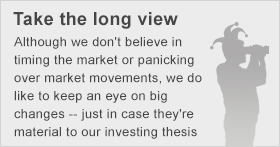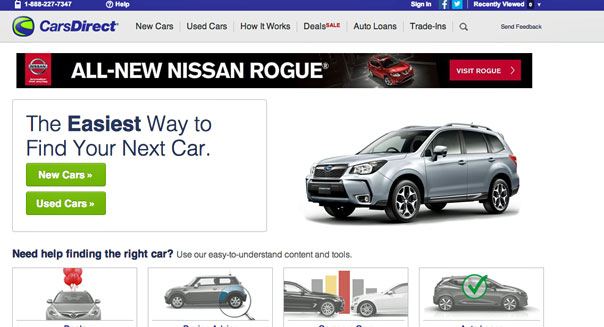It looks like any other recent Ford F-150. But secretly, this pickup at a Barrick Mining operation in Nevada was built with an aluminum cargo box as part of a Ford durability test. Source: Ford Motor Co.
Ford really wants you to know that their all-new aluminum-bodied F-150 is a tough truck.
This past week, Ford released more details of a secret field-testing program that began in 2011, in which some of Ford's big commercial-fleet clients put aluminum-bodied F-150s to work.
We'd heard a bit about that testing program from Ford COO Mark Fields and other executives when the new truck was first revealed back in January. But now we know a lot more.
These field tests were part of an unprecedented testing program for the all-new F-150, in which engineers went far beyond Ford's usual durability tests to ensure that the new truck's aluminum body would hold up to plenty of hard use.
What did Ford learn from those tests? Enough to make even Ford's top executives really confident about the 2015 F-150's chances.
They were just ordinary F-150s... with a secret change
The experimental pickups that Ford sent to three of its longtime commercial-fleet clients weren't actually all-new 2015 F-150s. That would have been too obvious, and Ford didn't want the testers to know exactly what they were testing.
Instead, Ford built six special prototypes, 2011 F-150s with experimental aluminum-alloy cargo boxes. Those were sent to three longtime Ford fleet customers -- who didn't know what they were getting.
Ford's engineers wanted to see how well the aluminum cargo beds would hold up under harsh real-world use.
And they were harsh. I asked Ford's Larry Queener, who ran the testing program, to explain just how harsh the testing regimen was -- and how well the experimental trucks held up.
Queener told me that the two prototype trucks at Barrick Gold's mines near Elko, Nev., were used by the company's surveying team, driving 100-300 miles a day over tough terrain -- often right into mine pits. "There are no county roads out there," he emphasized. The trucks drove over dirt and rocks and up and down hills, all day -- often with unsecured heavy equipment bouncing around in back.
The F-150s at Barrick are driven on rough dirt roads, often with heavy gear in the cargo box. Source: Ford Motor Co.
A utility company in North Carolina assigned one of their F-150s to a meter-reading team that regularly traveled on steep mountain roads. A third client, a construction company, put their F-150s to use at a hydroelectric dam project in Pennsylvania. Again and again, the trucks' aluminum pickup boxes were loaded with equipment and bounced over rough terrain.
Did the trucks' aluminum cargo boxes hold up? Yes. All six trucks are still in use.
Did the users notice something different about the trucks? Well, Ford prototype engineer Denis Kansier -- who visited the sites to check on the trucks every three months -- said that some drivers noticed that the truck's beds didn't develop surface rust where the paint was scratched away, something that's typical with steel-bodied pickups.
And they didn't crumple like beer cans. For the most part, they held up like... regular F-150s, Queener says. in fact, Queener thinks that after 75,000-plus miles of hard commercial use, the trucks in the test might have looked a bit better than a steel-bodied pickup would have.
But Queener emphasizes that Ford learned some lessons from the tests -- and those lessons led to changes in the trucks that will go into production later this year. Among other changes, Ford increased the thickness of the cargo box's floor and made revisions to the tailgate to improve its long-term durability.
A massive testing program has made Ford very confident
These customer tests were just one small part of the elaborate testing program for the new F-150 -- but Queener points out that Ford learned lessons from those tests that it might otherwise have had to wait to learn from the experience of its paying customers.
Queener said that by the time the first 2015 F-150 rolls off the assembly line later this year, the company will have accumulated the equivalent of 10 million miles of durability testing on its new truck. That's significantly above and beyond Ford's usual new-product testing.
A typical day for the F-150s at Barrick's site in Nevada includes trips over terrain like this -- with no paved roads in sight. Source: Ford Motor Co.
But it begs a question: Why is Ford going to such great lengths to test its new truck -- and to make sure we know about all the testing?
The simple answer is that Ford is making a big change to its most important product, its most profitable product -- and it wants truck customers, and Ford investors, to know why it thinks this is a good change.
By switching to a tough aluminum alloy for the body panels on the new F-150, Ford will be able to make each truck hundreds of pounds lighter than the current model -- up to 700 pounds lighter in some configurations.
That will improve the trucks' fuel economy (and their handling, and their towing capacities). Ford believes that the aluminum alloy they're using, and the construction techniques they've chosen for the new trucks, will allow its customers to get those benefits with no downsides.
The company believes that its new F-150s will be just as rugged and durable as the current trucks. They believe that because of all the testing they've done, and Ford officials want us to know just how extensive that testing has been, so that we believe it too.
The new F-150 won't be the last new lightweight Ford
It's no secret that gas is a lot more expensive than it used to be, and that the world's governments are imposing ever-tighter restrictions on new vehicles' fuel economy.
All consumer vehicles, from small cars to big pickups, will need to get better fuel economy in coming years. Not only to meet those regulations, but as a competitive advantage.
Your pickup's gas mileage may not matter a lot to you personally. But it matters to businesses. Commercial customers buy a lot of pickups. Being able to show a commercial truck-fleet manager that your pickups will get better gas mileage without compromising performance -- that they'll be cheaper to run over time -- can make the difference between a big sale, and no sale.
Each of the big global automakers is taking a different approach to meeting tougher fuel-economy regulations. Some are pushing more aggressively into hybrid drivetrains, or fuel-cell powerplants, or battery-electric vehicles, or advanced construction materials like carbon fiber. Most are doing all of those things to some extent, but each company has its own emphasis.
Like most of its major rivals, Ford is working on all of those things. But Ford is also making a big companywide effort to make its vehicles lighter, without compromising durability or safety.
The extensive use of aluminum in the all-new 2015 F-150 is a very high-profile change. Ford could have chosen a much more conservative route, like General Motors did with its new 2014 Chevy Silverado.
But Ford thinks that reducing the weight of its products, without significantly changing how they function, is a good way to realize fuel-economy gains without the need to rely on new technology. There are more weight-saving changes coming in future Ford products, as the company does all it can to get the most out of current technology.
What do you think? Has Ford made the case for its new truck, or do you need to see more to be convinced that it'll hold up in the real world? Scroll down to leave a comment with your thoughts.
Special report: Take advantage of this little-known tax "loophole"
Recent tax increases have affected nearly every American taxpayer. But with the right planning, you can take steps to take control of your taxes and potentially even lower your tax bill. In our brand-new special report "The IRS Is Daring You to Make This Investment Now!," you'll learn about the simple strategy to take advantage of a little-known IRS rule. Don't miss out on advice that could help you cut taxes for decades to come. Click here to learn more.
Copyright © 1995 - 2014 The Motley Fool, LLC. All rights reserved. The Motley Fool has a disclosure policy.





























